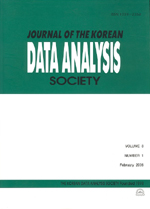벡터자기회귀 모형 추정을 위한 베이지안 축소 방법론 비교 연구
A Comparison Study of Bayesian Shrinkage Methods for Vector Autoregressive Models
- 한국자료분석학회
- Journal of The Korean Data Analysis Society (JKDAS)
- Vol.18 No.4
-
2016.081857 - 1870 (14 pages)
- 31

벡터자기회귀 모형은 다변량 시계열 자료를 분석하기 위해서 가장 널리 사용되는 모형으로 거시경제, 금융 분야에서 시계열 자료의 동태적 움직임을 분석하고 예측하는데 대표적으로 사용된다. 벡터자기회귀 모형을 분석함에 있어서 주의해야 할 점은 종속변수의 수와 시차(time lag)에 따라서 추정해야 할 모수의 수가 기하급수적으로 증가하는 과모수화 문제이다. 본 논문에서는 베이지안 축소 방법(shrinkage methods)을 통해서 이와 같은 문제를 살펴보고, 총 7가지의 사전분포를 통한 축소 방법들을 고려하도록 한다. 각 방법들의 예측 성능을 비교하기 위해서 모의실험을 수행하고, 예측성능 지표로써 절대예측오차와 제곱근평균제곱예측오차를 고려한다. 추가적으로 한국의 소비자 물가 지수, 실업률 그리고 수익률 변수로 구성된 3변수 VAR 모형을 통한 실증적 자료 분석을 수행한다.
Vector autoregressive (VAR) model is the most widely used in analysis of multi-variate time series data, and it has been used to analyze and predict the dynamic interrelationships of time series data in macro-economics and financial applications. One of the most important issues to be considered in analyzing the VAR model is over-parametrization, which implies that the number of parameters to be estimated in the model increases exponentially as the number of dependent variables and the time lag increase. In this paper, we examine such a problem in view of Bayesian shrinkage methods. using seven different prior specifications. We carry out the simulation studies to compare the predictive performance of each method. in terms of the mean absolute forecast error and the root mean squared forecast error. Additionally, we perform the empirical analysis of real data, consisting of consumer price index, unemployment rate and interest rate in Korea.
1. 서론
2. 베이지안 벡터자기회귀 모형
3. 모의실험
4. 실증분석
5. 결론
References
(0)
(0)